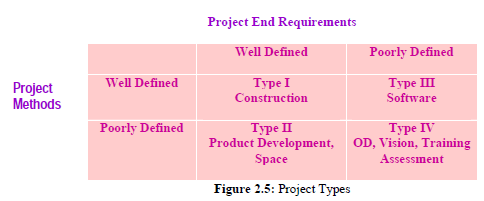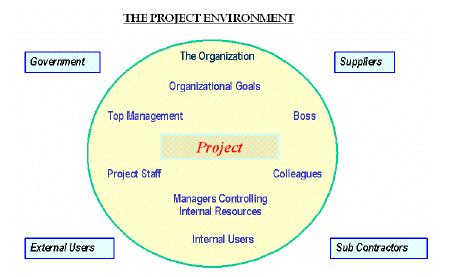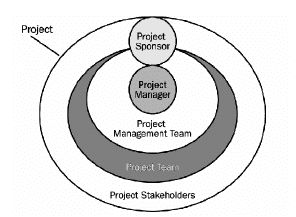Characteristics of Project: A problem scheduled for a solution is called a project. The gap between the current position and the desired position is referred to as a problem and there may present some hindrance that precludes the convenient movement to fill the gap.
The project is composed of a set of activities that should be carried out to obtain certain objectives in a certain time and certain locality. In other words, the temporary effort made to develop a unique product, service, or result is said to be a project.

Project is referred to as an investment on which resources are employed to make assets that will generate benefits over a wide period of time. Project is a unique process that contains a group of coordinated and controlled activities having beginning & end dates and these activities are performed to accomplish certain objectives in the light of some requirements including time, resources and cost constraints.
Characteristics of Project in Project Management
The following are some of the important characteristics of the project.
- The project is temporary with a certain starting & ending date.
- The opportunities and teams of the project are also for a temporary duration.
- Projects are ended when the goals are accomplished or when the goals are not achieved.
- Often projects continue for many years but still, their duration is finite.
- Multiple resources are involved in the projects along with close coordination.
- Interdependent activities are involved in the project.
- A unique product, service, or result is developed at the end of the project. There is also some extent of customization in the project.
- Complex activities are included the projects which need repetitive acts and are not simple.
- There is also some sort of connection in the activities of the project. Some sequence or order is also required in the activities. The output of certain activity becomes the input of another activity.
- There is an element of conflict in project management. For resources & personnel, the management should compete with the functional departments.
- Permanent conflict is associated with resources of the project and leadership roles which are important in solving the problems of the project.
- Clients desire changes in every project and the parent organization desires to maximize its profits.
- There is a possibility of two bosses in the project at a single time, each with different objectives and priorities.
Types of Projects
The following are four types of projects.
- Type I Projects (Large Engineering Projects)
These projects contain well-defined project end requirements and methods. An example includes construction projects.
- Type II Projects (Early Space Projects, Product Development Projects)
These projects have well-defined project end requirements but have poorly defined project methods.
- Type III Projects (Software Development Projects)
The shape of the end products proceeds in these projects. They have poorly defined project requirements but well-defined project methods.
- Type IV Projects (Organizational Development Projects)
These projects have both poorly defined project end requirements and project methods.
On the basis of duration, the following are further two types of projects.
- Short Range Projects
- Long-Range Projects
Short Range Projects
Short-range projects are those projects which are finished within one year and they focus on the accomplishment of the tactical objectives. There are less strict which means that little risk is associated with these projects. Short-range projects are not cross-functional.
They are less sophisticated and need limited project management tools. It is not difficult to get approval, organizational support and funding for short-range projects. For example, minimize fault in the shop no 3 from 7% to 4%.
Long-Range Projects
A high level of risk is present in long-range projects and suitable feasibility analysis is required before beginning such a project. Long-range projects are mostly cross-functional projects. The internal, as well as the external environment of an organization, is influenced by these projects. Potential resources are needed to consider such projects by taking effective initiatives by the members.
Reasons for Initiation of Projects
In the following scenarios, projects are initiated
- For development or modification of the project
- For starting a new business
- For closing or reallocating a facility
- For some community issues
- For regulatory mandate
- For the implementation of a new system or process
- For the re-engineering process so that recycle time & complaints are reduced and errors are eliminated.
- For the introduction of new tools, equipment or techniques
Attributes of a Project
In comparison with the program, a single goal is focused on the project. The end results affect the customers. These projects should be finished within a specified budget & time frame and in the light of the specifications.
In short, the projects are
- Directed towards accomplishing a particular result.
- Coordination of the interrelated activities undertaken.
- Of a certain duration with starting and an ending date.
- Influenced by a risk that must be present to some extent in the project.
Project Environment
All the projects are planned and executed in an economic, social, political, environmental and international context.
- Cultural and Social Environment
This environment includes how people are affected by the project and how they in turn affect the project. This needs comprehension of demographic, economic, ethnic, religious, ethical and cultural sensitivity issues.
- International & Political Environment
The understanding of international, national, regional, or local customs and laws is covered in this area. Furthermore, certain other factors are also included like teleconferencing facilities, time zone differences, national holidays, level of technology usage and travel means & logistic requirements.
- Physical Environment
The knowledge about physical geography and local ecology is included in this kind of project environment that can influence the project or influenced by the project.
Project Participants
Project participants include the stakeholders who have the interest or share in the company. The stakeholders of the company contain directors, management shareholders, government, suppliers, customers, employees and community. The outcomes and objectives of the company influence these stakeholders.
They have different levels of authority and responsibility so they should not be neglected. The project manager must attempt to accomplish & manage the expectations of the shareholders. Both negative and positive stakeholders are present.
The individuals or organizations that are participating actively are considered as project stakeholders. Stakeholders can also be those whose interests are influenced by the completion or execution of the project. The objectives and outcomes of the projects are also influenced by them.
So it is quite beneficial for the project management team to point out stakeholders by ascertaining their expectations and requirements so that these can be better managed to make the project successful.
The following are some of the main key stakeholders of the project.
- Project Manager
The individual who has the responsibility to manage the project is considered as a project manager.
- Customer or End-User
Customers or end-users are those persons or organizations that will utilize the product of the project.
- Performing Organization
The performing organization is the one whose employees are most directly participate in performing the project work.
- Project Management Working on Project
These include the team members who are participating directly in the activities of the project management.
- Project Team Members
The group that is doing the project work is considered as project team members. It contains the members who are directly participating in the activities of the project.
- Sponsors
The person or group that supplies financial resources for the project in cash or any other kind is referred to as a sponsor.
- Influencers
People or groups that although does not involve directly in the project but can indirectly influence the project positively or negatively are called influencers.
- Project Management Organization
Project management organization can be included in the performing organization where it acts as a stakeholder by taking responsibility for the results of the project.
Sub Projects
Projects are mostly split into more manageable components which are called subprojects. The single subproject is also itself a project and is managed in the same sense. They can be outsourced or subcontracted.
Examples of Characteristics of Project
The following are some of the practical examples of the projects.
- Hosting a website of a certain department
- In a revenue collection department, designing & implementation of an auto tax filing system
- Keeping an alumni reunion of a university
- Developing a new product or service
- Supply of clean water to the nation of a particular country by 2020
- Acquiring or developing new or modified information system
- Making a change in the staffing, style or structure of an organization
Operations and Projects
The ongoing & repetitive activities performed by the staff are considered as operations like
- Continuous manufacturing
- Product distribution
- Financial management & control
Projects are unique & temporary and are performed by teams that have
- Effective and open communication systems
- Clearly specified individual & team roles
- The clear reward for better performance and have consistent pressure to better the poor performance
Following are some of the common characteristics between projects and operations
- Both of them are performed by people
- Both of them are planned, executed and controlled
- Both are restricted by limited resources

Hello everyone! This is Richard Daniels, a full-time passionate researcher & blogger. He holds a Ph.D. degree in Economics. He loves to write about economics, e-commerce, and business-related topics for students to assist them in their studies. That's the sole purpose of Business Study Notes.
Love my efforts? Don't forget to share this blog.







